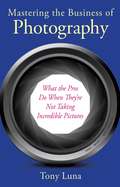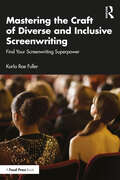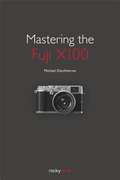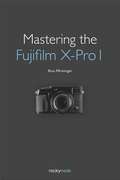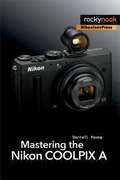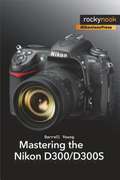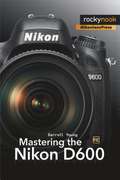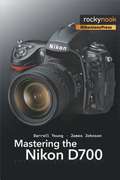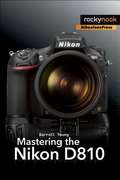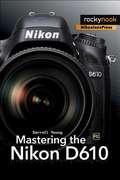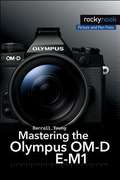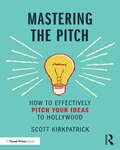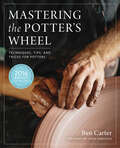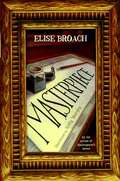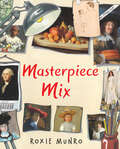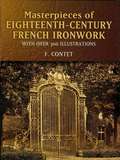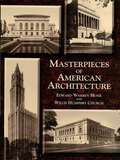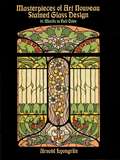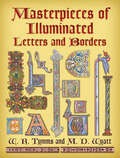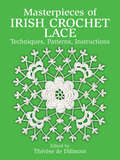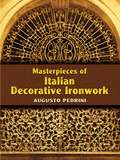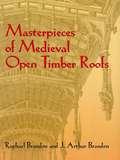- Table View
- List View
Mastering the Business of Photography: What the Pros Do When They're Not Taking Incredible Pictures
by Tony LunaPhotography can be a competitive and unforgiving trade, however there are many strategies for professional success. This book is a resource for photographers of all kinds and demonstrates the many ways to manage a career in photography, while still "earning enough money to support yourself, a family, your interests, your aspirations, and your passion." Mastering the Business of Photography offers insights into what happens when you're not shooting-which is most of the time-and explains what you must do to further your career, make a living, and accomplish your personal goals. Topics include: Organizing assignments from start to finish Creating a plan and calculating risks Building a standout portfolio Anticipating financial matters Working with clients Self-promoting Getting paid Booking gigs Negotiating a contract And much moreFor freelance photographers and for those employed by agencies as well, this guide is full of practical advice for navigating the world of photo work, coming from an industry professional with over forty years of experience.
Mastering the Craft of Diverse and Inclusive Screenwriting: Find Your Screenwriting Superpower
by Karla Rae FullerThis accessible and informative textbook provides a guide to the craft of screenwriting with an emphasis on diverse perspectives, underrepresented groups and their screen stories. Readers will learn to master writing a feature-length screenplay in a framework that focuses on diversity, equity and inclusion. With case studies to aid understanding, the book explores the screenwriting process in stages, explaining how to create a logline, as well as character bios, writing and choosing a genre, differentiating between writing a treatment, a synopsis, composing an outline, incorporating the formatting process and finally creating a scene and sequence. The techniques specific to screenwriting will also be covered in the text such as writing dialogue and action, establishing setting and time period and most importantly mastering the craft of visual storytelling. At the same time, the textbook introduces concepts of content choices that are diverse and inclusive, such as stereotypes vs. archetypes, intersectional characters, underrepresented groups and themes such as social justice, systemic racism, class conflict, gender inequity and climate change.Due to its subject matter and inclusive approach, this textbook will be an essential guide for all aspiring and current screenwriters who want to successfully navigate and complement today’s developing industry.
Mastering the Fuji X100
by Michael DiechtierowMastering the Fuji X100 provides the ambitious photographer with everything they need to know to operate this camera that has become an instant classic. Readers will learn about the features and capabilities of the X100 and will discover numerous tips and tricks for how to maximize its potential. Learn how to influence dynamic range, how to optimize focus, which film simulation is best, and much more. The Fuji X100 is a premium digital viewfinder camera that combines compact size with sophisticated technical features and uncompromising optical quality. This unique camera already enjoys cult status and is used by many photographers as the ideal travel and snapshot camera. Nonetheless, the X100 is much more than an automatic snapshot camera--it is a sophisticated photographic tool. In a layout suitable to the camera's attractive design, this manual presents convincing imagery that attests to the fun you will have as you begin to push the envelope of your Fuji X100.
Mastering the Fujifilm X-E1 and X-Pro1
by Rico PfirstingerMastering the Fujifilm X-E1 and X-Pro1 provides a wealth of experienced-based information and insights for owners of Fuji's mirrorless X-E1 and X-Pro1 system cameras. Readers will learn about the features and capabilities of these cameras and will discover numerous tips and tricks for how to maximize their potential. The book also covers lenses and key accessories, as well as various post-processing options. With the X-E1 and X-Pro1, Fujifilm released two affordable mirrorless system cameras with APS-C sensors that rival modern full-frame cameras. The successful combination of high-end retro design and state-of-the-art digital camera technology, originally seen in the X100 viewfinder camera, has now been pushed even further. The systems offer a number of FUJINON interchangeable zoom and prime lenses, and several more have been announced. In a layout suitable to the cameras' attractive design, this manual presents imagery that attests to the fun you will have as you begin to push the envelope of your Fujifilm X-E1 or X-Pro1.
Mastering the Fujifilm X-Pro 1
by Rico PfirstingerMastering the Fujifilm X-Pro 1 provides a wealth of experienced-based information and insights for owners of the new X-Pro 1 camera. Readers will learn about the features and capabilities of the X-Pro 1 and will discover numerous tips and tricks for how to maximize its potential. With the X-Pro 1, Fujifilm released the first mirrorless camera with an APS-C sensor. The successful combination of high-end retro design and state-of-the-art digital camera technology, originally seen in the X100 viewfinder camera, has been pushed even further to achieve this interchangeable-lens camera. The X-Pro 1 offers three FUJINON interchangeable lenses. In a layout suitable to the camera's attractive design, this manual presents imagery that attests to the fun you will have as you begin to push the envelope of your Fujifilm X-Pro 1.
Mastering the Microsoft Kinect: Body Tracking, Object Detection, and the Azure Cloud Services
by Vangos PterneasKnow how to program the Microsoft Kinect and use the device for applications that interact directly with humans through gestures and motion. This book covers the mathematics and theoretical background needed for depth sensing, motion tracking, and object recognition while maintaining a practical focus on getting things done. You will learn to track the human body in three-dimensional space, analyze the human motion, and remove the background to isolate the person being tracked. You will see how to recognize objects and voice, and transform between the three-dimensional physical space and a computer’s two-dimensional screen.The book is written with real-world applications in mind. It provides step-by-step tutorials and source code for common use cases. The author has worked with startups and Fortune 500 companies, and all of the examples are taken directly from the industry. The book’s practical focus simplifies the core principles, removes the clutter, and allows developers to start writing code right away. Also covered is the use of Azure Cognitive Services on Microsoft’s cloud platform and their use for object and voice recognition, enabling your applications to “see” objects and respond to their environment.What You Will LearnVisualize color, depth, and body dataCalculate angles between different body jointsAnalyze human motion and create fitness applicationsRecognize objects and voice using cloud-powered artificial intelligenceRemove the background from a scene to create virtual worldsWho This Book Is ForDevelopers who want to build demanding Kinect apps and games, and those who are looking for a careful balance between theoretical knowledge and practical application that favors the practical. Readers should have a basic knowledge of C# and some familiarity with the Unity3D engine.
Mastering the Nikon COOLPIX A
by Darrell YoungMastering the Nikon COOLPIX A by Darrell Young provides experience-based information for owners of the new COOLPIX A camera. In this ebook, Darrell helps the user navigate past the confusion that often comes with learning to use complex camera equipment. This ebook explores the features and capabilities of the camera in a way that far surpasses the user's manual. It includes an in-depth look at the camera's controls and functions. It guides readers through the camera features with step-by-step setting adjustments; color illustrations; and detailed explanations for each option. Every button, dial, and menu configuration setting is explored in a user-friendly manner, with suggestions for setup according to various shooting styles. Darrell's friendly and informative writing style allows readers to easily follow directions. In this new COOLPIX A manual, Darrell provides information on the camera's functions, as well as basic photography techniques, as part of the complete learning experience.
Mastering the Nikon D300/D300S
by Darrell Young<p>Mastering the Nikon D300/D300S, by Darrell Young, provides a wealth of experience-based information and insights for owners of these powerful and sophisticated cameras. Darrell is determined to help the user navigate past the confusion factor that often comes with complex but powerful new professional camera equipment.<br/><br/>\nThe book explores the features and capabilities of the two cameras in a way that completely surpasses user's manuals. It guides readers through the DSLR camera features with step-by-step setting adjustments, color illustrations, and detailed explanations for each option. Each button, dial, switch, screen, and menu configuration option is explored in a user-friendly manner, with suggestions for setup according to various shooting styles.<br/><br/>\nDarrell Young's friendly and informative writing style allows readers to easily follow directions, while feeling as if a friend dropped in to share his knowledge. The learning experience for D300/D300S beginners-and refresher information for professionals-goes beyond just the camera itself. Detailed explanations cover White Balance, the Histogram, the Multi-CAM 3500DX autofocus system, and how the Live View and D-Movie modes work. Camera accessories such as Speedlight flash and GPS units are also considered.</p>
Mastering the Nikon D5000
by Darrell YoungMastering the Nikon D5000 by Darrell Young is a comprehensive guide for of the owners of this newest, budget-friendly generation of Nikon digital single lens reflex (DSLR) cameras. The smaller, more lightweight Nikon D5000 mixes generous portions of user-controlled manual photography features with the latest technological innovations, allowing fully automatic point and shoot simplicity. Darrell's approach in helping the reader to master this camera avoids the purely instructional technique, favoring a more friendly and advisory tone. He blends his decades of Nikon camera experience with an intuitive understanding of the readers' most likely questions regarding specific camera functions and features. Rather than just list all options for the myriad of camera settings and adjustments, he explains the background behind each setting and shares his personal recommendations. Darrell understands that many owners of the D5000 may be just entering the world of DSLRs, and he takes the time to guide these new owners through the basics, while giving more experienced photographers the option of a refresher course. Also included is an entire chapter on the exciting new D-Movie function that can record high-quality HD movie clips at an amazing 24-frames per second. Mastering the D5000 is the most recent volume in the highly successful series of Nikonians Press books.
Mastering the Nikon D700
by Darrell Young James JohnsonMastering the Nikon D700 provides a wealth of information and professional insights for owners of this powerful new camera. Each chapter explores the features and capabilities of the D700 in detail, surpassing basic user manuals by providing step-by-step menu setting adjustments coupled with illustrations and logical explanations for each option. The authors' writing style allows the reader to follow directions in a friendly and informative manner, as if a friend dropped in to share his experienced knowledge without "talking down" to you, explaining the how and the why. The learning experience for D700 beginners (and refresher information for professionals) goes beyond the camera itself. When camera features and options expand to additional Nikon equipment (such as with the use of optional Speedlights) the authors add the necessary information. Their frequent references to user manuals provided by Nikon (complete with specific page references) allow the reader to easily navigate past the confusion factor that often comes with new equipment.
Mastering the Nikon D800
by Darrell YoungMastering the Nikon D800 by Darrell Young provides a wealth of experience-based information and insights for owners of the new D800 camera. Darrell is determined to help the user navigate past the confusion that often comes with complex and powerful professional camera equipment. This book explores the features and capabilities of the camera in a way that far surpasses the user's manual. It guides readers through the camera features with step-by-step setting adjustments; color illustrations; and detailed how, when, and why explanations for each option. Every button, dial, switch, and menu configuration setting is explored in a user-friendly manner, with suggestions for setup according to various shooting styles. Darrell's friendly and informative writing style allows readers to easily follow directions, while feeling as if a friend dropped in to share his knowledge. The learning experience for new D800 users goes beyond just the camera itself and covers basic photography technique.
Mastering the Nikon D90
by Darrell YoungThe Nikon D90 is the long-awaited upgrade to the popular D80 digital SLR. The D90 sits between the D60 and D300 in Nikon's DSLR lineup, though many of its features come from its more expensive sibling. In this book, Darrell Young provides a wealth of information and professional insights for owners of this powerful new camera. Each chapter explores the features and capabilities of the D90 in detail, surpassing basic user manuals by providing step-by-step menu setting adjustments coupled with illustrations and logical explanations for each option. Darrell Young's writing style allows the reader to follow directions in a friendly and informative manner, as if a friend dropped in to share his experienced knowledge without "talking down" to you, explaining the how and the why. Darrell gives special emphasis to the amazing HD movie capabilities of the D90, which create new possibilities for the creative photographer. Mastering the Nikon D90 is the fourth volume in the highly successful series of Nikonians Press camera books.
Mastering the Olympus OM-D E-M1
by Darrell YoungOlympus launched the OM-D E-M1 camera with a specific purpose in mind: to create a Micro Four Thirds camera for professional and advanced enthusiast photographers. As the flagship Micro Four Thirds camera, the E-M1 is the peak of the Olympus digital imaging system. It is a true system camera for those who demand the best in cameras, lenses, and image quality.Darrell Young's Mastering the Olympus OM-D E-M1 explores the features and capabilities of the camera in a way that far surpasses the user's manual. It is designed to guide readers through the camera's features with step-by-step setting adjustments; color illustrations; and detailed how, when, and why explanations for each option. Every button, dial, switch, and menu configuration setting is explored in a user-friendly manner, with suggestions for setup according to various shooting styles.Darrell's friendly and informative writing style allows readers to easily follow directions while feeling as if a friend dropped in to share his knowledge. The learning experience for new E-M1 users goes beyond just the camera itself and covers basic photography technique.This book is based on firmware 3.0.
Mastering the Pitch: How to Effectively Pitch Your Ideas to Hollywood
by Scott KirkpatrickTold from the perspective of a Hollywood executive with nearly 20 years’ experience professionally pitching and distributing film/TV projects, Mastering the Pitch reveals all the nuanced details of the pitching process. Readers will gain valuable insights into how the Hollywood system operates, improve their professional pitching skills and gain a competitive edge in getting their ideas from concept to greenlight. This book covers: how projects are packaged and developed before a pitch; how a pitch presentation happens in a real-world setting; the core concepts required to pitch each genre type; how professional companies actually acquire a pitched project; the legal workflows and financial details required to put a deal together; examples of pitch documents, presentation materials and how these elements should be designed; how to build your personal brand so that you’re seen by Hollywood decision makers as someone capable of delivering great projects; and how you should speak to professionals about the business viability of your projects Mastering the Pitch is a valuable crossover text, designed to help both students and veteran film/TV producers alike hone their pitching and presentation skills.
Mastering the Potter's Wheel: Techniques, Tips, and Tricks for Potters (Mastering Ceramics)
by Ben CarterTake your skills—and your work—to the next level with this comprehensive guide to wheel-throwing that includes more than just the basics.Mastering the Potter’s Wheel starts with an introduction to wheel-throwing, from centering to creating the basic forms. What pushes this book beyond the competition, however, are the techniques offered in the chapters that follow. From a variety of methods for throwing large objects such as pitchers and platters, to alterations, darting, and paddling, this book offers potters a world of possibilities.With galleries featuring today’s top working artists, including Kyle Carpenter, Sam Chung, Chandra DeBuse, Julia Galloway, Martha Grover, Ayumie Horie, Forrest Lesch-Middleton, Kristen Kieffer, Kathy King, Matt Long, Alex Matisse, Lorna Meaden, Doug Peltzman, Mackenzie Smith, Shawn Spangler, and many more, you’ll also find page after page of inspiration . . . The Mastering Ceramics series is for artists who never stop learning. With compelling projects, expert insight, step-by-step photos, and galleries of work from today’s top artists, these books are the perfect studio companions. Also available from the series: Mastering Hand Building and Mastering Kilns and Firing.Praise for Mastering the Potter’s Wheel“The ultimate “how to pot” book, this is a must read for anyone pursuing his or her craft through a mindful and holistic approach.” —Sarah Millfelt, director, Northern Clay Center“A valuable resource for anyone interested in learning more about handmade pottery. The book provides clear instructions, thoughtful insights, and includes beautiful images of work from some of the best potters in the field.” —Steve Lee, director, Archie Bray Foundation for the Ceramic Arts“Ben’s thorough knowledge and extensive experience in ceramics comes to the fore in this comprehensive book—helpful advice for beginners with loads of tutorials, well-considered guidance for those with more experience, and galleries of examples to inspire into the future. This book deserves a place on the bookshelf in every ceramics studio” —Vicki Grima, editor, The Journal of Australian Ceramics
Masterpiece
by Elise BroachIn this follow-up to "Shakespeare's Secret," Broach delivers a fast-paced mystery in which a young boy and a beetle attempt to pull off a staged art heist at the Metropolitan Museum of Art.
Masterpiece Mix
by Roxie Munro37 masterpieces inspire an artist in this introduction to art history that includes a search-and-find game. "Today I will make a new painting," declares an artist, but first she must build a stretcher to stretch the canvas; select which paints, brushes, and palette knives to use; and, most importantly, decide what to paint. Will she paint a still life in the style of Robert S. Duncanson or a portrait in the manner of Mary Cassatt? Using reproductions of art from the National Gallery of Art by Vincent van Gogh, Judith Leyster, Claude Monet and others pivotal figures in art history, Roxie Munroe introduces readers to a variety of iconic artists, art styles, and time periods. The sweeping painting she creates by the book's end cleverly incorporates all 37 pieces she has considered. Eagle-eyed readers will love finding the works of art in her painting and learning more about the artists in the notes in the back matter. You'll want to start building canvases and mixing colors for a masterpiece of your very own!
Masterpieces of Eighteenth-Century French Ironwork: With Over 300 Illustrations
by F. ContetThis magnificent display of all 166 plates from an extremely rare set of portfolios depicts scores of examples of the ironworker's art, among them beautiful gates, balustrades, balcony railings, window grilles, church screens, and lantern holders. A superb collection of royalty-free images for use by designers, architecture enthusiasts, and lovers of antiques.
Masterpieces of American Architecture: Museums, Libraries, Churches and Other Public Buildings
by Willis Humphrey Church Edward Warren HoakFrom the golden age of American architecture comes this splendid survey, documenting scores of masterpieces built between 1900 and 1930. More than 260 illustrations include plans, sections, exterior and interior details, and photographs. A sampling of featured buildings include Lincoln Memorial, Boston Public Library, Tribune Tower, and Woolworth Building.
Masterpieces of Art Nouveau Stained Glass Design: 91 Motifs in Full Color (Dover Pictorial Archive)
by Arnold LyongrünMagnificent motifs reproduced from rare original edition: florals, foliates, female figures, pastoral landscapes, more. Ideas for craftspeople and designers.
Masterpieces of Furniture in Photographs and Measured Drawings: Third Edition
by Verna Cook SalomonskyThis well-known reference work has been consulted by generations of collectors, curators, dealers, historians, and craftsmen, and it remains in use decades after its initial publication. Photographs and measured drawings of the most striking furniture pieces of the sixteenth through nineteenth centuries constitute the major part of the book; the accompanying text indicates stylistic features and developments, prototypes, types of wood, function, and location of the original. Selected mainly from collections in the Metropolitan Museum of Art, Boston Museum of Fine Arts, and the Museum of the Rhode Island School of Design, the objects include chests, tables, chairs, dressing tables, desks, highboys, commodes, couches, and other furniture. Periods and styles include Colonial American, Duncan Phyfe, Windsor, Sheraton, Hepplewhite, Chippendale, Louis XIV, eighteenth-century Dutch, sixteenth-century Italian, and representatives of other eras. The book's most outstanding features are the measured drawings for each piece of furniture. Accurate to the nearest 1/16th of an inch, these drawings are especially valuable for woodworkers creating detailed replicas.
Masterpieces of Illuminated Letters and Borders (Dover Pictorial Archive)
by W. R. Tymms M. D. WyattMore than 350 decorative designs in this impressive collection, including 256 letters, display the glories of extant medieval manuscripts. Exceptionally rare letters and borders that once enhanced medieval bibles and other rare manuscripts are ornamented with exquisite florals, gem-like geometrics, curvilinear motifs interwoven with religious figures, and superb embellishments.Comprising a practical archive of usable lettering for artists and craftworkers alike, this impressive collection also provides medievalists with a wonderful glimpse of the ancient art of manuscript illumination.
Masterpieces of Irish Crochet Lace: Techniques, Patterns, Instructions
by Thérèse De DillmontIn recent years Irish crochet lace has enjoyed a tremendous revival among needleworkers. Nearly lost in the early twentieth century when machines took over the manufacture of most lace, the craft is now being rediscovered by enthusiasts who recognize it not only as one of the most durable, serviceable, and beautiful forms of lace but also as a type that provides a unique opportunity to be creative.This inexpensive volume presents authentic motifs and grounds used by the most skilled Irish needleworkers of the late nineteenth century. Collected and edited by one of the best-known experts of the time, Thérèse de Dillmont, it offers patterns, complete instructions, and/or detailed photographs for 30 motifs, 12 intricate grounds, and various traditional footings and borders.Crocheters can use these versatile motifs of delicate raised flowers, leaves, sprays, and more to transform ordinary bedspreads, doilies, tablecloths, and clothing into works of art to be treasured for years. Make your own unique designs for new curtains, fancy collars, delicate cuffs, and so much more. Each of these motifs can be altered in shape, enlarged, diminished, or combined in new patterns -- there's virtually no limit to the results you can produce.Beginners should practice making individual motifs before attempting an entire piece of lace, and experienced crocheters may want to follow the directions exactly before experimenting to form new motifs. With practice, you can invent your own patterns just by employing these authentic, elemental motifs and their complementary grounds. A new introduction relates the history and technique involved in Irish crochet lace, and a conversion chart translates outdated terms.
Masterpieces of Italian Decorative Ironwork (Dover Jewelry and Metalwork)
by Augusto PedriniThis magnificently illustrated volume showcases elegant examples of ironwork designs by five centuries of Italian masters. Spanning the fourteenth through the eighteenth centuries, the collection encompasses both simple and elaborate ornaments for doors, windows, gates, balcony and staircase railings, and other architectural features. A remarkable variety of motifs are depicted--from gracefully executed florals and foliated elements, to exquisite swirls and curls, and striking portrayals of mythical beasts.A dazzling treasury of ornamental ironwork, this archive of royalty-free motifs will delight lovers of antiques, commercial artists, and anyone intrigued by decorative flourishes from the past.
Masterpieces of Medieval Open Timber Roofs
by Raphael Brandon J. Arthur BrandonExcellently framed and designed, with bold, receding arches, the open timber roofs of the medieval period featured massive moldings, carved timbers, and intricate tracery. Today, these roofs are recognized for their striking beauty, rich ornamentation, and the consummate skills of the carpenters and builders who crafted them.This excellent reproduction of a rare nineteenth-century volume includes numerous full-page illustrations and construction details revealing a wealth of information on the major roof styles (tie-beam, trussed rafter, hammer-beam, and collar-braced) of medieval English churches. More than 50 illustrations of 34 English churches are included, among them the exquisite double hammer-beam roof of Knapton Church in Norwich, the richly ornamented roof over Trinity Chapel, Cirencester Church, in Gloucestershire, and the magnificent roof over Wymondham Church, in Norfolk, in which hammer-beams, boldly projecting into the nave, are exquisitely carved into figures of angels with expanding wings. These and many more masterly constructions are captured in the authors' own geometric and perspective drawings (done on-site), superbly reproduced here in detailed, highly accurate engravings. In addition to a wealth of pictorial detail, the authors also provide an informative general introduction to the major types of roof construction, as well as expert commentary on each individual roof, describing its distinguishing characteristics, ornament, measurements, and other details.Artists and illustrators will prize these beautifully rendered plates for their beauty and detail, while architects, antiquarians, and lovers of things medieval will appreciate the authenticity of the plates and the knowledgeable commentary of the architect-authors.
